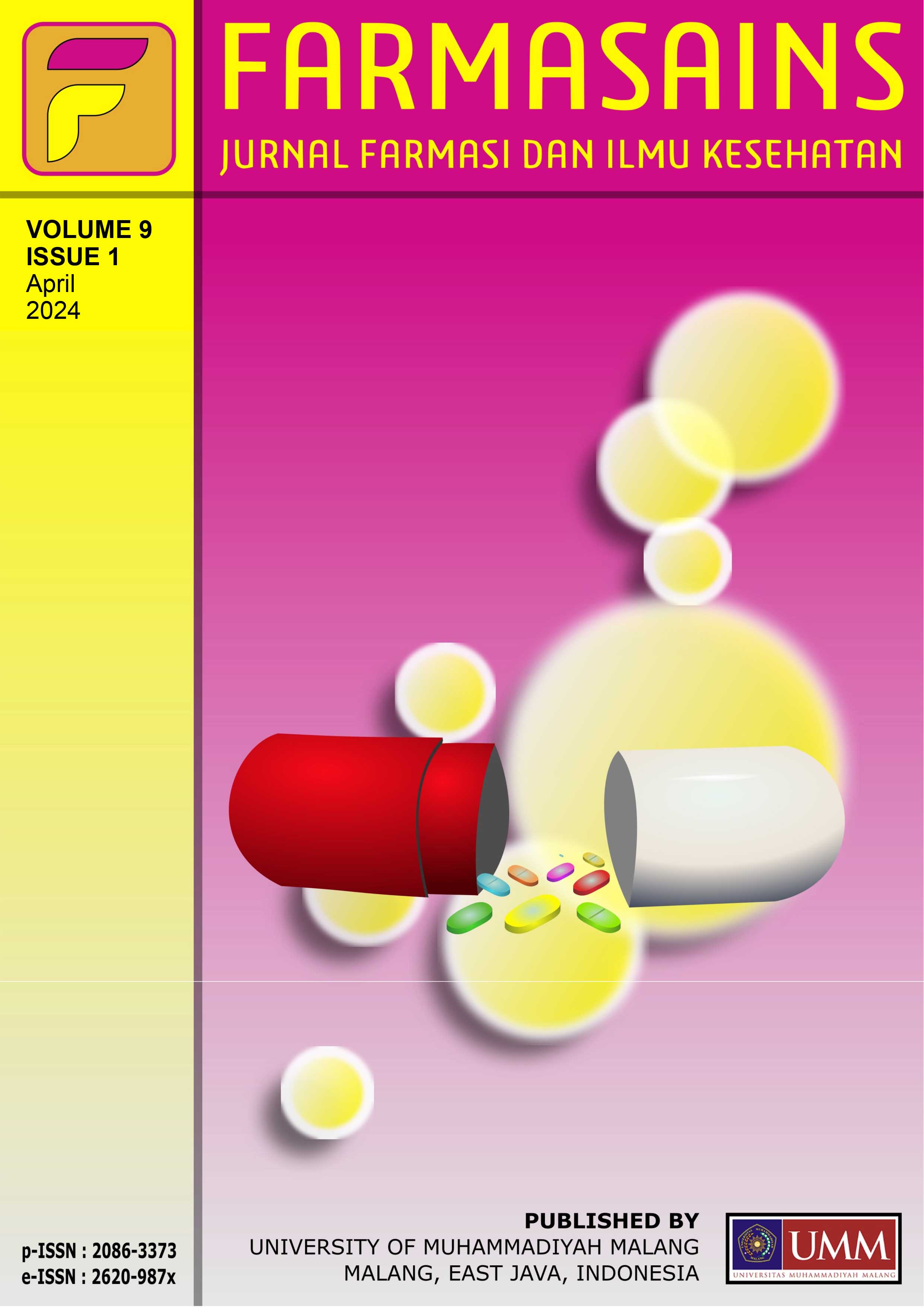Antibacterial effectiveness of belimbing wuluh leaf extract (Averrhoa bilimbi L.) and meniran herb (Phyllanthus niruri L.) against Staphylococcus epidermidis
DOI:
https://doi.org/10.22219/farmasains.v9i1.33127Keywords:
Combination, Extract, Meniran herb, Starfruit leaves, Staphylococcus epidermidisAbstract
Acne is an inflammatory condition of the skin which is commonly called polysebaceous which is caused by the Staphylococcus epidermidis bacteria. Meniran herbs and starfruit leaves contain compounds that are used as antibacterials, namely tannins, flavonoids and saponins. The purpose of this study was to determine the effectiveness of the antibacterial combination of star fruit wuluh leaf extract (Averrhoa bilimbi L.) and meniran herb (Phyllanthus niruri L.) as an antibacterial in inhibiting the growth of the Staphylococcus epidermidis bacteria that causes acne. The research was an experimental study by conducting an antibacterial effectiveness test against Staphylococcus epidermidis bacteria. The results of this research are that the combination of meniran herb extract and starfruit can inhibit the growth of Staphylococcus bacteria. A 1:3 combination of starfruit leaf extract (Averrhoa bilimbi L.) and meniran herb (Phyllanthus niruri L.) is effective in inhibiting the growth of Staphylococcus epidermidis bacteria 8.568 mm (Medium).
Downloads
References
Adrianto, D., Kumala, S., & Indrawati, T. (2021). Development of an Anti-Acne Gel Preparation Combination of Meniran Herbal Extract (Phylanthus niruri L.) and Soursop Leaf Extract (Annoni muricata L.). Journal of Social Science , 1 (11), 118–123. https://doi.org/10.36418/sosains.v1i11.250
Afifi, R., Erlin, E., & Rachmawati, J. (2018). Anti - Bacterial Test of Starfruit Leaf Extract (Averrhoa bilimbi L.) Against Acne Bacterial Inhibitory Zones Propionibacterium acnes I n V itro . Quagga : Journal of Education and Biology , 10 (01), 10. https://doi.org/10.25134/quagga.v10i01.803
Alegantina, S., Setyorini, HA, & Triwahyuni. (2015). Qomuality Assay and Quantitative Determination of Phyllanthin Fr. Bul. Researcher. Health , 43 (1), 11–16.
Andiarna, F., Irul, H., & Eva, A. (2020). Health Education on the Appropriate and Effective Use of Antibiotics as an Effort to Overcome Drug Resistance. Journal of Community Engagement and Employment, 2 (1), 15–22.
Dewangga, VS, & Qurrohman, MT (2019). Antibacterial Potential of Ethanol Extract of Green Meniran Herb ( Phyllanthus niruri Linn.) in Inhibiting the Growth of Staphylococcus aureus. Kusuma Husada Health Journal , 144–150. https://doi.org/10.34035/jk.v10i2.390
Ergina, Nuryanti, S., & Pursitasari, Indriyani Dwi. (2014). Qualitative Test of Secondary Metabolite Compounds in Palado Leaves ( Agave Angustifolia ) Extracted With Water and Ethanol. J. Akad. Kim , 3 (3), 165–172.
Hatur Rahman, M. (2021). Antibacterial Activity Test of the n-hexane Fraction from Meniran Leaf Extract ( phyllanthus niruri L.) Against the Growth of Salmonella sp. Scientific , 7 (2), 96–104. https://doi.org/10.31605/saintifik.v7i2.331
Muthmainnah, B. (2017). Phytochemical Screening of Secondary Metabolite Compounds from Pomegranate ( Punica granatum L.) Fruit Extract using the color test method. Makasar Polytechnic Pharmaceutical Media , XIII (2), 6–18.
Putri, DM, & Lubis, SS (2020). Phytochemical Screening of Kalayu Leaf Extract ( Erioglossum rubiginosum (Roxb.) Blum). Amina , 2 (3), 120–121.
Saleh, M., & Pasanda, OS (2019). Utilization of Herbal Plants as Natural Antibiotics to Increase the Performance Index (Ip) of Broiler Chickens. INTEK: A Research Journal , 6 (2), 150. https://doi.org/10.31963/intek.v6i2.1584
Saragih, DF, Opod, H., & Pali, C. (2016). The relationship between the level of self-confidence and acne ( Acne vulgaris) in class XII students at SMA Negeri 1 Manado. Journal of e-Biomedicine , 4 (1), 0–7. https://doi.org/10.35790/ebm.4.1.2016.12137
Suryaningsih, S. (2016). Starfruit ( Averrhoa Bilimbi ) as a source of energy in G alvani cells .Journal of Physics Research and Applications (JPFA) , 6 (1), 11. https://doi.org/10.26740/jpfa.v6n1.p11-17
Wijayanti, TRA, & Safitri, R. (2018). Test of the Antibacterial Activity of Starfruit Leaf Extract ( Averrhoa Bilimbi Linn) Against the Growth of Staphylococcus Aureus Bacteria that Cause Postpartum Infections. Care: Scientific Journal of Health Sciences , 6 (3), 277. https://doi.org/10.33366/cr.v6i3.999
Wulandari, RAS (2017). Formulation and Test of Antibacterial Activity of Stapylococcus epidermidis Microemulsion Preparation of Kersen Leaf Extract ( Muntingia calabura Linn.) with Isopropyl mirystate oil phase. In THESIS .
Yanti, S., & Vera, Y. (2019). Phytochemical screening of starfruit leaf extract (Averrhoa bilimbi). Indonesian Health Scientific Journal (Indonesian Health Scientific Journal) , 4 (2), 41–46.
Yulia, R., Putri, R., & Wahyudi, R. (2020). Study of the Level of Community Knowledge Regarding the Use of Antibiotics at the Rasimah Ahmad Bukittinggi Community Health Center. Journal of Pharmaceutical And Sciences , 2 (2), 43–48. https://doi.org/10.36490/journal-jps.com.v2i2.25
Downloads
Published
How to Cite
Issue
Section
License
Copyright (c) 2024 Ariaditya Wibowo, Agnes Yuliana, Dwi Puspita Sari

This work is licensed under a Creative Commons Attribution 4.0 International License.
Authors who publish with this journal agree to the following terms:
a. Authors retain copyright and grant the journal right of first publication with the work simultaneously licensed under a Creative Commons Attribution License that allows others to share the work with an acknowledgement of the work's authorship and initial publication in this journal.
b. Authors are able to enter into separate, additional contractual arrangements for the non-exclusive distribution of the journal's published version of the work (e.g., post it to an institutional repository or publish it in a book), with an acknowledgement of its initial publication in this journal.
c. Authors are permitted and encouraged to post their work online (e.g., in institutional repositories or on their website) prior to and during the submission process, as it can lead to productive exchanges, as well as earlier and greater citation of published work (See The Effect of Open Access).













